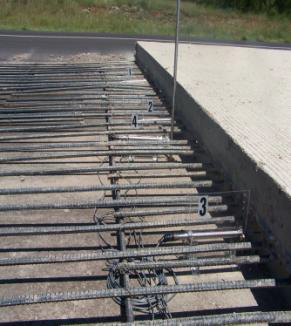Project 5-4893
Continuously Reinforced Bonded Concrete Overlay of Distressed Jointed Concrete Pavements
There have been distresses and performance issues in jointed plain concrete pavement (JCP) in Sherman, Paris District. The pavement, 10 in. slab on 6 in. flexible base and lime treated subgrade, was built in 1984. Major distresses include transverse cracking and faulting in longitudinal joint between outside lane and outside shoulder. Forensic investigations revealed that the subbase support was neither uniform nor adequate. Substantial repair work has been done; however, the distresses continued to develop. Currently, there are no optimum rehabilitation strategies available for deteriorated JCP. To evaluate whether continuously reinforced concrete pavement (CRCP) bonded overlay can provide an optimum rehabilitation strategy, CRCP bonded overlay was constructed on half a mile section of JCP on US 75 southbound from Exit 64. Slab thickness and longitudinal steel reinforcement were 7 in. and 0.7 %, respectively. To optimize the performance of this rehabilitation method, the following requirements are incorporated in the specifications and design details; (1) maximum coefficient of thermal expansion (CTE) of concrete less than 4.6 microstrain/°F, (2) wet-mat curing for at least 7 days, (3) the placement of longitudinal steel 4 in. from the concrete surface, (4) placement of non-woven fabric on transverse contraction joints, (5) installation of hook bars at the interface between old and new concrete at transition areas. Various gages were installed to investigate the behavior of CRCP overlay system due to environmental loading. Also, deflection testing was conducted before and after overlay with falling weight deflectometer (FWD). In-situ drying shrinkage of concrete was quite small, and in-situ CTE was close to the specification value. Deflection testing conducted before the overlay showed that many transverse joints had low load transfer efficiency (LTE) even though dowels were used. After the overlay, the deflections were reduced substantially, with the average of 1.02 mils. This deflection is comparable the deflections in 14 or 15 in.-thick normal CRCP. It is expected that this section will provide good long-term performance, and future performance will be monitored under TxDOT rigid pavement database project 0-6274.

Project PI: Moon C. Won
Center for Multidisciplinary Research in Transportation (TechMRT)
-
Address
Texas Tech University, Box 41023, Lubbock, TX 79409-1023 -
Phone
806.742.3523 -
Email
techmrt.outreach@ttu.edu
